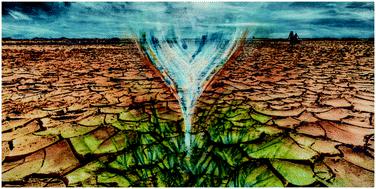当前位置:
X-MOL 学术
›
Environ. Sci.: Water Res. Technol.
›
论文详情
Our official English website, www.x-mol.net, welcomes your
feedback! (Note: you will need to create a separate account there.)
Energy performance and climate dependency of technologies for fresh water production from atmospheric water vapour
Environmental Science: Water Research & Technology ( IF 3.5 ) Pub Date : 2020-06-26 , DOI: 10.1039/d0ew00128g Robin Peeters 1, 2, 3, 4 , Hannah Vanderschaeghe 1, 2, 3, 4 , Jan Rongé 1, 2, 3, 4 , Johan A. Martens 1, 2, 3, 4
Environmental Science: Water Research & Technology ( IF 3.5 ) Pub Date : 2020-06-26 , DOI: 10.1039/d0ew00128g Robin Peeters 1, 2, 3, 4 , Hannah Vanderschaeghe 1, 2, 3, 4 , Jan Rongé 1, 2, 3, 4 , Johan A. Martens 1, 2, 3, 4
Affiliation

|
Extraction of water vapour from atmospheric air and condensing it to liquid water for human usage is an imaginative solution to the water scarcity problem. Atmospheric water vapour is a large and readily accessible fresh water source able to fulfil human water needs. Many systems that draw water vapour from the air with water collecting surfaces, desiccant materials such as zeolites, silica gels, MOFs, polymers and salts and aids such as membranes have been proposed. Much progress has been made in increasing water harvesting efficiency, reducing cost and improving applicability especially in the extreme atmospheric conditions of arid regions. But all these systems are energy intensive and this energy demand for water production is an important element of the water-energy nexus. In this paper the intrinsic energy requirements of water vapour capturing processes in different atmospheric conditions are quantified as the specific water yield (L kW−1 h−1). Distinction is made between passive systems that use natural phenomena like solar energy directly, and active systems with human transformation of the energy vector. The generation of thermoelectric energy involves water use and may even lead to overall water consumption instead of production. Technologies involving air cooling to provoke condensation of the water vapour reach specific water yields of 1–4 L kW−1 h−1 but their application is strongly dependent on atmospheric conditions. A specific water yield of 0.1–1 L kW−1 h−1 is commonly achieved for an ad/absorption–desorption cycle with a desiccant material. Depending on climate conditions, either passive systems with desiccants or active cooling of condensation surfaces is energy wise the optimum choice. The intrinsic energy requirements of atmospheric water harvesting are more than hundred times larger than seawater desalination. Fundamentally new concepts are needed to make atmospheric water an affordable fresh water source.
中文翻译:

利用大气水蒸气生产淡水的技术的能源绩效和气候依赖性
从大气中提取水蒸气并将其冷凝为液态水供人类使用,是解决缺水问题的一种有想象力的解决方案。大气水蒸气是一种大型且易于获取的淡水源,能够满足人类的用水需求。已经提出了许多利用集水表面从空气中吸取水蒸气的系统,诸如沸石,硅胶,MOF,聚合物和盐的干燥剂以及诸如膜的助剂。在提高集水效率,降低成本和提高适用性方面取得了很大进展,特别是在干旱地区的极端大气条件下。但是所有这些系统都是能源密集型的,对水生产的这种能源需求是水能源关系的重要组成部分。-1 h -1)。直接使用自然现象(例如太阳能)的无源系统与通过人为转换能量矢量的有源系统之间是有区别的。热能的产生涉及用水,甚至可能导致整体用水而不是生产。涉及空气冷却以引起水蒸气冷凝的技术可达到1-4 L kW -1 h -1的特定水产量,但其应用在很大程度上取决于大气条件。比水产量0.1–1 L kW -1 h -1通常在干燥剂材料的吸附/吸附-解吸循环中实现。根据气候条件,无论是带干燥剂的被动式系统还是凝结面的主动式冷却都是明智的能源选择。大气水收集的内在能量需求比海水淡化大一百倍。从根本上需要使大气水成为负担得起的淡水源的新概念。
更新日期:2020-07-31
中文翻译:

利用大气水蒸气生产淡水的技术的能源绩效和气候依赖性
从大气中提取水蒸气并将其冷凝为液态水供人类使用,是解决缺水问题的一种有想象力的解决方案。大气水蒸气是一种大型且易于获取的淡水源,能够满足人类的用水需求。已经提出了许多利用集水表面从空气中吸取水蒸气的系统,诸如沸石,硅胶,MOF,聚合物和盐的干燥剂以及诸如膜的助剂。在提高集水效率,降低成本和提高适用性方面取得了很大进展,特别是在干旱地区的极端大气条件下。但是所有这些系统都是能源密集型的,对水生产的这种能源需求是水能源关系的重要组成部分。-1 h -1)。直接使用自然现象(例如太阳能)的无源系统与通过人为转换能量矢量的有源系统之间是有区别的。热能的产生涉及用水,甚至可能导致整体用水而不是生产。涉及空气冷却以引起水蒸气冷凝的技术可达到1-4 L kW -1 h -1的特定水产量,但其应用在很大程度上取决于大气条件。比水产量0.1–1 L kW -1 h -1通常在干燥剂材料的吸附/吸附-解吸循环中实现。根据气候条件,无论是带干燥剂的被动式系统还是凝结面的主动式冷却都是明智的能源选择。大气水收集的内在能量需求比海水淡化大一百倍。从根本上需要使大气水成为负担得起的淡水源的新概念。











































 京公网安备 11010802027423号
京公网安备 11010802027423号